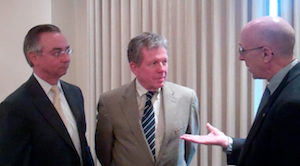 After the recent American Subcontractors Association (ASA) panel on the origins and current status of the Construction Career Collaborative (C3) movement in the Houston region, Construction Citizen caught up with two of the panelists to get their reactions and any additional comments they might want to add to the conversation.
After the recent American Subcontractors Association (ASA) panel on the origins and current status of the Construction Career Collaborative (C3) movement in the Houston region, Construction Citizen caught up with two of the panelists to get their reactions and any additional comments they might want to add to the conversation.
Peter Dawson, Senior Vice President of Facilities Services at Texas Children’s Hospital, and John Roberts, Executive Vice President of Jones Lang LaSalle’s Project and Development Services Group, are newly elected to the C3 Board of Directors and have been strong advocates of C3 concepts such as paying construction workers by the hour as employees, paying appropriate taxes on the workforce and providing the construction workforce with the best safety training available.
Their comments follow:
Jim Kollaer: You both did a great job on the panel today. As an owner and an owner’s representative on the panel, we wanted to ask what you thought of the comments you heard and what you think the next steps are?
Peter Dawson: This [meeting] obviously demonstrates that the interest is growing, and the word is getting out to the construction community. This is a first step and is something that people need to get involved in. So people will leave here and think about getting involved with [C3]. At Texas Children's, we became involved in the program because of the promise for the future and the understanding that we share in that promise and its benefits. It’s at our own peril if we don't see this and try to demonstrate leadership in helping get [C3] off the ground. I think today what you see is some momentum in building the fabric of our industry and something that we expect as an everyday part of our business.
John Roberts: I think the majority of discussions among panelists pointed in the same direction; that it is incumbent on us as owners, contractors, and subcontractors, to figure out how we can build a labor pool interested in staying in the industry. There are several benefits in this, not in the least of which is we’ll hopefully end up with a higher quality in our projects and lower maintenance costs by integrating workers who are incentivized to grow, learn and stay in this business. The question isn’t whether the subcontractors buy into this. They already buy into this, but they're just looking for everyone else to buy into this. It [C3 support] needs to continue to gather momentum to move forward in a positive way.
Jim Kollaer: The owners are driving this C3 process on the projects. What does that mean to you?
Peter Dawson: I think it demonstrates the fact that there's a buyer out there for this; that the value of this (C3 program) is understood, recognized, and is something that we want to go out and incorporate into our projects. We don't see this as a dead-end cause. We see this is an investment in our company and our high-value projects.
John Roberts: In an age where sustainability and LEED and other initiatives have a long-term approach within the industry, it is high time that this industry takes the same approach, along with other industries like oil and gas and manufacturing. We need to take care of the entire growth of our work force.
Jim Kollaer: This need for a qualified workforce and C3 buy-in, will it become more important as we begin to experience shortages in the skilled labor that is showing up now in places like Phoenix?
Peter Dawson: People are going to be competing for scarce labor of “who knows what kind of quality”, certainly not as high we are trying to get to. It will cost more to get that labor as the economy heats up and the competition for skilled labor increases.
Jim Kollaer: We want to thank you both again for taking a leadership role with the C3 program on your projects.



Add new comment